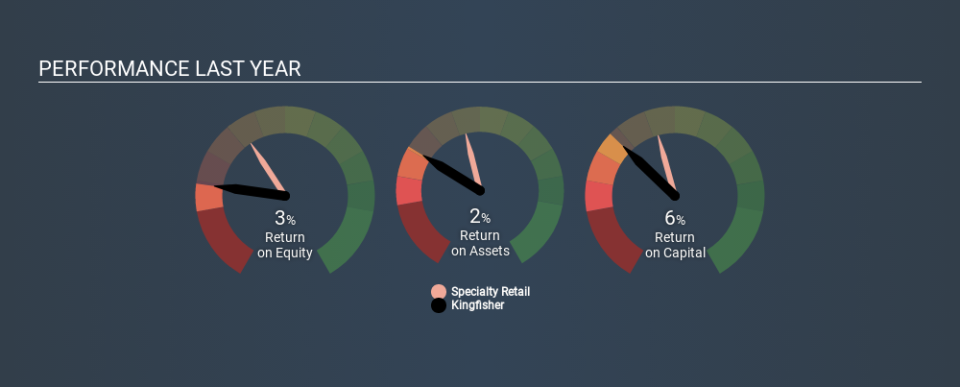Why We’re Not Impressed By Kingfisher plc’s (LON:KGF) 6.5% ROCE

Today we are going to look at Kingfisher plc (LON:KGF) to see whether it might be an attractive investment prospect. To be precise, we'll consider its Return On Capital Employed (ROCE), as that will inform our view of the quality of the business.
First up, we'll look at what ROCE is and how we calculate it. Second, we'll look at its ROCE compared to similar companies. And finally, we'll look at how its current liabilities are impacting its ROCE.
Return On Capital Employed (ROCE): What is it?
ROCE measures the 'return' (pre-tax profit) a company generates from capital employed in its business. Generally speaking a higher ROCE is better. In brief, it is a useful tool, but it is not without drawbacks. Author Edwin Whiting says to be careful when comparing the ROCE of different businesses, since 'No two businesses are exactly alike.
How Do You Calculate Return On Capital Employed?
Analysts use this formula to calculate return on capital employed:
Return on Capital Employed = Earnings Before Interest and Tax (EBIT) ÷ (Total Assets - Current Liabilities)
Or for Kingfisher:
0.065 = UK£595m ÷ (UK£12b - UK£3.2b) (Based on the trailing twelve months to July 2019.)
So, Kingfisher has an ROCE of 6.5%.
View our latest analysis for Kingfisher
Is Kingfisher's ROCE Good?
When making comparisons between similar businesses, investors may find ROCE useful. Using our data, Kingfisher's ROCE appears to be significantly below the 9.3% average in the Specialty Retail industry. This could be seen as a negative, as it suggests some competitors may be employing their capital more efficiently. Setting aside the industry comparison for now, Kingfisher's ROCE is mediocre in absolute terms, considering the risk of investing in stocks versus the safety of a bank account. Readers may find more attractive investment prospects elsewhere.
Kingfisher's current ROCE of 6.5% is lower than 3 years ago, when the company reported a 10% ROCE. Therefore we wonder if the company is facing new headwinds. You can click on the image below to see (in greater detail) how Kingfisher's past growth compares to other companies.
Remember that this metric is backwards looking - it shows what has happened in the past, and does not accurately predict the future. ROCE can be misleading for companies in cyclical industries, with returns looking impressive during the boom times, but very weak during the busts. ROCE is only a point-in-time measure. Future performance is what matters, and you can see analyst predictions in our free report on analyst forecasts for the company.
Do Kingfisher's Current Liabilities Skew Its ROCE?
Current liabilities are short term bills and invoices that need to be paid in 12 months or less. Due to the way the ROCE equation works, having large bills due in the near term can make it look as though a company has less capital employed, and thus a higher ROCE than usual. To counter this, investors can check if a company has high current liabilities relative to total assets.
Kingfisher has current liabilities of UK£3.2b and total assets of UK£12b. As a result, its current liabilities are equal to approximately 26% of its total assets. This is a modest level of current liabilities, which would only have a small effect on ROCE.
What We Can Learn From Kingfisher's ROCE
If Kingfisher continues to earn an uninspiring ROCE, there may be better places to invest. You might be able to find a better investment than Kingfisher. If you want a selection of possible winners, check out this free list of interesting companies that trade on a P/E below 20 (but have proven they can grow earnings).
If you like to buy stocks alongside management, then you might just love this free list of companies. (Hint: insiders have been buying them).
If you spot an error that warrants correction, please contact the editor at editorial-team@simplywallst.com. This article by Simply Wall St is general in nature. It does not constitute a recommendation to buy or sell any stock, and does not take account of your objectives, or your financial situation. Simply Wall St has no position in the stocks mentioned.
We aim to bring you long-term focused research analysis driven by fundamental data. Note that our analysis may not factor in the latest price-sensitive company announcements or qualitative material. Thank you for reading.

 Yahoo Finance
Yahoo Finance 
